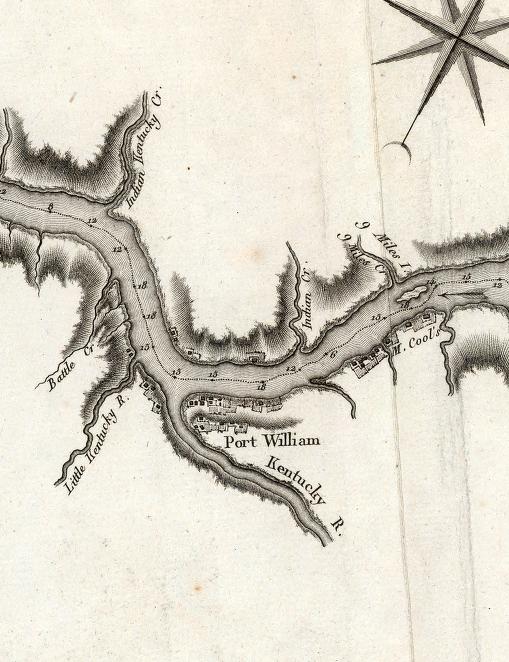In terms of what is generally accepted about history, this title makes no sense. There weren't any battles in Jefferson County, unless you want to count the Pigeon Roost Massacre. And although that took place in Jefferson County as it existed at the time, its locale is modern Scott County. And while Morgan's raiders liberated a lot of hams at Dupont, there were no battles in the Jefferson County segment of that incursion.
But there are indications that there were at least two battles in the county, perhaps three. So given the lack of records for the area before 1810, why not more?
The first battle was Creek versus Shawnee, a confrontation that took place George Ash, always recounted as Indian George, returned to European civilization in Kentucky about 1796 and before he relocated to the area between Lamb, Ind., in Switzerland County, and the border with Milton Township, Jefferson County.
There are several versions of the story of Ash, captured as a boy in Nelson County, Ky., in 1780, and raised among the Shawnee in Ohio. Most dismiss his active involvement with the Indians in ambushing settlers or fighting against them. The least sanitized version was published in the Madison Progress [which I have not found] and reprinted in the Vevay Reveille of March 24 and 31, 1874. In it, Ash recounts two seasons of his dressing in European garb and standing on the northern Ohio shore pretending to be in distress in order to lure passing boats to their occupants' doom. They were successful in at least one of these in which Ash specifies that the Indians hid their canoes on the Indian-Kentucky near "Uncle Dick Bundren's [a spelling pronunciation of Bondurant] farm, which is probably around the location of modern Brooksburg Cemetery.
The exact location of the confrontation is not clear nor its example time. It was in September and it occurred the year after the camp out near the Bondurant farm. Ash said that the Shawnee had returned from a raid in Nelson County, his former home, near where Bethlehem, Ind., is located. They "built a temporary craft in the low grounds,
north of where the city of Madison
now stands ... " camped there for some time with no luck in their attempts to prey on boats and then moved upstream to a location opposite the mouth of the Kentucky River. This all occurred sometime before the signing of the Greenville Treaty in 1795 since most Indian fighting ceased at that point.
Whenever this occurred, the Shawnee had been fighting with the Creek sometime the year before. During their stay in this episode, they received word of a Creek troop advancing. They moved upriver and decided to form a line between the hill and the river bank. Unfortunately, the exact location of the original camp or the amount distance they moved upriver is not given. However, it would seem that if they moved up river into Switzerland County, the bottoms grow wide enough that covering the ground from hill to river would have taken many more men.
The battle lasted about three hours into the afternoon when the Shawnee attacked and drove the Creeks in a running fight for two or three miles. Unfortunately, Ash did not state the direction. He did report the Creek lost 20 braves and the Shawnee about 10 men out of 110 with 32 more wounded and six of those died later. Ambushes involving the Creeks continue through the next winter and the Shawnee stayed on the north side of the Ohio to avoid a fight.
There is less clear evidence for a battle by George Rogers Clark's troops that may have occurred in Milton Township. The possibility is implicit in the original name of Locust Creek - Battle Creek - which is just downstream from the mouth of the Little Kentucky River. Gen. Charles Scott's 791 mounted troops crossed at the mouth of the Kentucky River or at Battle Creek in 1791, depending on which contemporary account you believe.
 There's no indication his troops fought anyone in southeastern Indiana as did they in the north. What we do know is the name Battle Creek is on a 1793 map that covers the area. What is not certain is why the creek bears that name but it is clearly labeled on Barker's 1793 map, along with the equally clearly labeled Indian-Kentuck.
There's no indication his troops fought anyone in southeastern Indiana as did they in the north. What we do know is the name Battle Creek is on a 1793 map that covers the area. What is not certain is why the creek bears that name but it is clearly labeled on Barker's 1793 map, along with the equally clearly labeled Indian-Kentuck.
One report has Clark fighting a battle on the Indiana side opposite Battle Creek about 1793, but I have not been able to substantiate that. It is also not clear if it were the same or a different battle from one that occurred in 1779 or 1780 that was described by Henry Wilson, who served in one of Clark's units.
Wilson said that McGary and Ellison's companies cross the Ohio at the mouth of the Kentucky River and about for or five miles, came upon a large Indian Camp on the bank of the river. Nine men in McGary's company were killed or wounded in the ensuing skirmish. He noted that "this little check put a stop to hunting on the shore."
Unfortunately, nothing in Wilson's account suggests whether troops had gone upriver, deeper into Switzerland County, or down river into Jefferson, before the fighting broke out.

